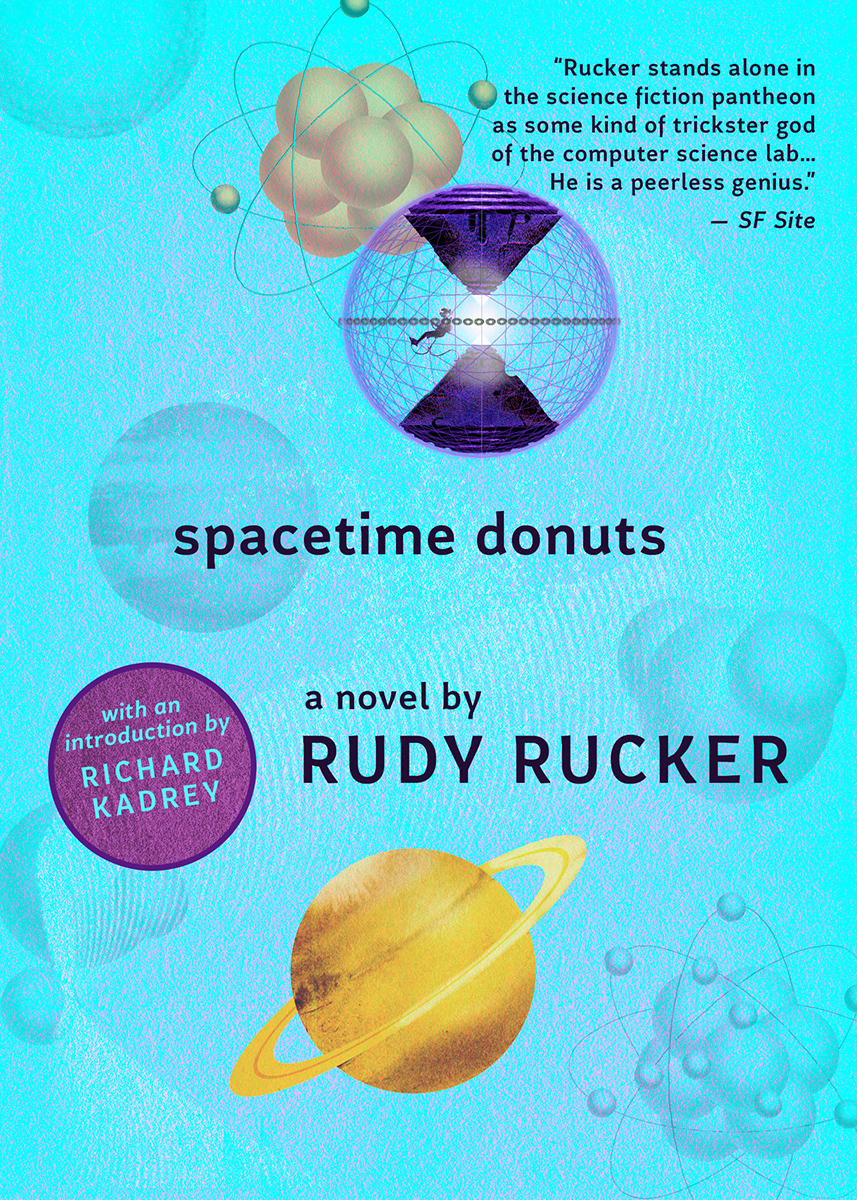|
Spacetime Donuts, by Rudy Rucker
Spacetime DonutsPaperback: Night Shade Books, July 2019, 3nd Edtion, with an introduction by Richard Kadrey. Buy the paperback on Amazon or Barnes & Noble. See Rucker's other nine Night Shade books. SummarySpacetime Donuts is a wild ride through the rubber science, an underground neo-SF classic, and a formative work of early cyberpunk. It contains a unique mix of hippie humor, true love, gonzo sensibilities, and huge computer called Phiswhiz. America is simply "Us," a collection of Users known as Drones and Dreamers, near-automatons whose every need is provided for. But Phizwiz lacks creativity, and his vapid entertainment is unfulfilling, especially for curious young Vernor Maxwell. Seeking to add a creative soul to Phizwiz, a hard-partying elite has learned how to plug their minds into the computer. Joining them, Vernor finds a way to build a scale-ship—and becomes an incredible shrinking man. He soon tunnels down below the atomic level and finds himself at the intergalactic top—with the power to smash the machine, once and for all. . . . ReviewsHip, humorous, and refreshing. — American Book Review. It’s all done up in great style and it marks an auspicious debut. — Roanoke, Virginia, Times & World News. He knows how to boggle the mind and, next chapter, to boggle it again. — Thomas M. Disch. Garbage in, garbage out. — Locus From the AuthorIn accord with my often-used transreal style, Spacetime Donuts is and SF novel that is in some ways based on my life. That is, the early sections of Spacetime Donuts were inspired by my experiences in graduate school, and the hero’s love interest was modeled on my wife Sylvia. Events strung themselves together in such a way that I was writing a Ph.D. thesis in set theory at Rutgers in 1972. Rutgers is near Princeton, where the great philosophical genius Kurt Gödel lived. I met him a couple of times and was profoundly affected. I wrote about him in my later nonfiction book Infinity and the Mind. And he inspired my Spacetime Donuts character G. Kurtowski. My wife Sylvia and I saw the Rolling Stones play in Buffalo in 1976, the week before I started writing Donuts. Someone scalped tickets to us outside, and we ended up in the third row. It had a big effect on me…the great thing was that the music was so loud you couldn’t tell, after a while, what the song was. And thus my character Mick Stones. Another big musical influence on this book is Frank Zappa, especially his album, Apostrophe’. The main science gimmick for Spacetime Donuts is something I call circular scale. The idea is sort of to take the classic SF film, The Incredible Shrinking Man—and to splice the last frame to the first. I got the idea for this in grad school, while perched in a tree near our apartment in Highland Park, New Jersey, near Rutgers. That scene made it into Spacetime Donuts, and I quote the scene in my best-selling popular science book Infinity and the Mind as well.
In Infinity and the Mind I came up with a scientific explanation for circular scale, as illustrated by the two figures above. If you want the full details, get hold of the book, or check the relevant section relevant section of the free online browsing version. Spacetime Donuts includes a cadre of characters able to plug their minds directly into their society’s Big Computer. In some ways this prefigures William Gibson’s epochal cyberpunk novel Neuromancer, where console cowboys jack their brains into the planetary computer net that Gibson dubbed cyberspace. In standard cyberpunk fashion, my characters in Spacetime Donuts take drugs, have sex, listen to rock, and freak out while contacting inhumanly intelligent artificial minds. One day, soon after writing Spacetime Donuts, I came across a new SF magazine called Unearth . It turned out that Unearth was printing only stories by previously unpublished SF authors, which seemed like a perfect opportunity. I got in touch with them, and Parts I and II of Spacetime Donuts came out in two successive issues of Unearth , starting in 1978. Unearth went out of business before my Part III could appear. But eventually Spacetime Donuts came out from Ace Books, from E-Reads, and from my own Transreal Books. I could have kept this, my maiden effort, just the same—as a historical artifact. But, being a writer, I couldn’t resist smoothing out the prose a little bit—without, I trust, diluting the 70s-style bad attitude which so-provoked the original Locus reviewer! |


